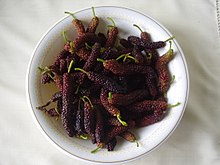
Ficus is a genus of about 850 species of woody trees, shrubs, vines, epiphytes and hemiepiphytes in the family Moraceae. Collectively known as fig trees or figs, they are native throughout the tropics with a few species extending into the semi-warm temperate zone. The common fig (F. carica) is a temperate species native to southwest Asia and the Mediterranean region, which has been widely cultivated from ancient times for its fruit, also referred to as figs. The fruit of most other species are also edible though they are usually of only local economic importance or eaten as bushfood. However, they are extremely important food resources for wildlife. Figs are also of considerable cultural importance throughout the tropics, both as objects of worship and for their many practical uses.

Morus, a genus of flowering plants in the family Moraceae, consists of diverse species of deciduous trees commonly known as mulberries, growing wild and under cultivation in many temperate world regions. Generally, the genus has 64 subordinate taxa, three of which are well-known and are ostensibly named for the fruit color of the best-known cultivar: white, red, and black mulberry, with numerous cultivars and some taxa currently unchecked and awaiting taxonomic scrutiny. M. alba is native to South Asia, but is widely distributed across Europe, Southern Africa, South America, and North America. M. alba is also the species most preferred by the silkworm, and is regarded as an invasive species in Brazil and the United States.
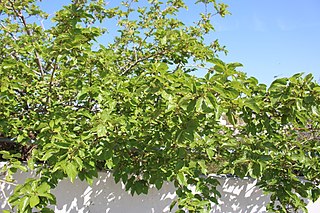
Morus alba, known as white mulberry, common mulberry and silkworm mulberry, is a fast-growing, small to medium-sized mulberry tree which grows to 10–20 m (33–66 ft) tall. It is generally a short-lived tree with a lifespan comparable to that of humans, although there are some specimens known to be more than 250 years old. The species is native to China and India and is widely cultivated and naturalized elsewhere.

Antidesma is a genus of tropical plant in the family Phyllanthaceae formally described by Linnaeus in 1753. It is native to tropical Africa, S + E + SE Asia, Australia, and various oceanic islands. The greatest diversity occurs in Southeast Asia.

Plant callus is a growing mass of unorganized plant parenchyma cells. In living plants, callus cells are those cells that cover a plant wound. In biological research and biotechnology callus formation is induced from plant tissue samples (explants) after surface sterilization and plating onto tissue culture medium in vitro. The culture medium is supplemented with plant growth regulators, such as auxin, cytokinin, and gibberellin, to initiate callus formation or somatic embryogenesis. Callus initiation has been described for all major groups of land plants.

Morinda is a genus of flowering plants in the madder family, Rubiaceae. The generic name is derived from the Latin words morus "mulberry", from the appearance of the fruits, and indica, meaning "of India".

Maclura tricuspidata is a tree native to East Asia, occasionally grown for its fruit, somewhat similar to that of the related mulberry. It is also known by common names including cudrang, kujibbong, storehousebush, mandarin melon berry, silkworm thorn, zhe or che, and Chinese mulberry. It grows up to 6 m high.

Morus rubra, commonly known as the red mulberry, is a species of mulberry native to eastern and central North America. It is found from Ontario, Minnesota, and Vermont south to southern Florida, and west as far as southeastern South Dakota, Nebraska, Kansas, and central Texas. There have been reports of isolated populations in New Mexico, Idaho, and British Columbia.

Multi-fruits, also called collective fruits, are fruiting bodies formed from a cluster of flowers, the inflorescence. Each flower in the inflorescence produces a fruit, but these mature into a single mass. After flowering, the mass is called an infructescence. Examples are the fig, pineapple, mulberry, osage-orange, and jackfruit.

Indole-3-butyric acid (1H-indole-3-butanoic acid, IBA) is a white to light-yellow crystalline solid, with the molecular formula C12H13NO2. It melts at 125 °C in atmospheric pressure and decomposes before boiling. IBA is a plant hormone in the auxin family and is an ingredient in many commercial horticultural plant rooting products.

Chrysobalanus icaco, the cocoplum, paradise plum, abajeru or icaco, is a low shrub or bushy tree found near sea beaches and inland throughout tropical Africa, tropical Americas and the Caribbean, and in southern Florida and the Bahamas. An evergreen, it is also found as an exotic species on other tropical islands, where it has become a problematic invasive. Although taxonomists disagree on whether Chrysobalanus icaco has multiple subspecies or varieties, it is recognized as having two ecotypes, described as an inland, much less salt-tolerant, and more upright C. icaco var. pellocarpus and a coastal C. icaco var. icaco. Both the ripe fruit of C. icaco, and the seed inside the ridged shell it contains, are considered edible.

Actinidia arguta, the hardy kiwi, is a perennial vine native to Japan, Korea, Northern China, and the Russian Far East. It produces a small kiwifruit without the hair-like fiber covering the outside, unlike most other species of the genus.

Dracaena reflexa is a tree native to Mozambique, Madagascar, Mauritius, and other nearby islands of the Indian Ocean. It is widely grown as an ornamental plant and houseplant, valued for its richly coloured, evergreen leaves, and thick, irregular stems.
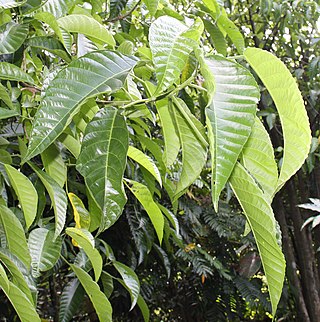
Dendrocnide is a genus of approximately 40 species of plants in the nettle family Urticaceae. They have a wide distribution across North East India, Southeast Asia, Australia and the Pacific Islands. In Australia they are commonly known as stinging trees.
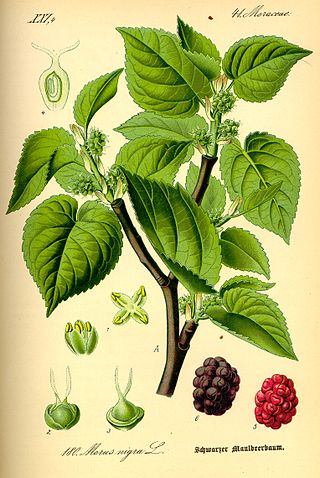
Morus nigra, called black mulberry, is a species of flowering plant in the family Moraceae that is native to southwestern Asia, where it has been cultivated for so long that its precise natural range is unknown. The black mulberry is known for its large number of chromosomes.
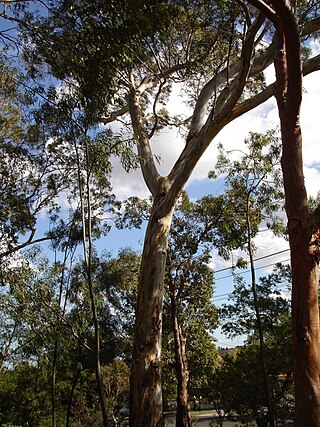
Eucalyptus leucoxylon, commonly known as yellow gum, blue gum or white ironbark, is a species of small to medium-sized tree that is endemic to south-eastern continental Australia. It has smooth yellowish bark with some rough bark near the base, lance-shaped or curved adult leaves, flower buds in groups of three and cylindrical, barrel-shaped or shortened spherical fruit. A widely cultivated species, it has white, red or pink flowers.
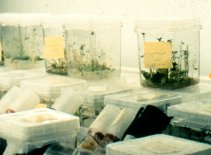
Plant tissue culture is a collection of techniques used to maintain or grow plant cells, tissues, or organs under sterile conditions on a nutrient culture medium of known composition. It is widely used, to produce clones of a plant in a method known as micropropagation. Different techniques in plant tissue culture may offer certain advantages over traditional methods of propagation, including:
Passiflora lindeniana is a species in the subgenus Astrophea, some species of which are weak trees and some are free standing woody trees. P. lindeniana is the largest of the free-standing trees, growing to 20 m, and having a circumference of 1.25 m at the base.
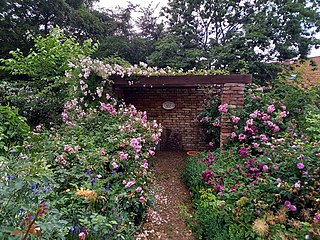
The Mulberry garden, originally Morušová zahrada in Czech, is a cottage garden in the Czech Republic, situated in the Czech Central Uplands in the village Režný Újezd, 7 kilometres (4.3 mi) northwest of the town Lovosice. The garden was established in 2014 by local gardeners admiring the English cottage garden style. Apart from different kinds of plants such as perennial plants, English historical roses, Czech roses, annual plants, and bulbs, several uncommon fruit trees are grown, especially various mulberry varieties. Mulberry garden is located along the green tourist track to Boreč hill in the grounds of former Gentlemen's farm, house no. 2.

Morus mongolica, also described as Morus alba var. mongolica, is a woody plant native to mountain forests in Mongolia, China, Korea, and Japan. Common names include Mongolian mulberry, meng sang (China), and ilama by native people in the namesake region of Mongolia. Similar to M. notabilis, M. mongolica is an uncultivated mulberry.
